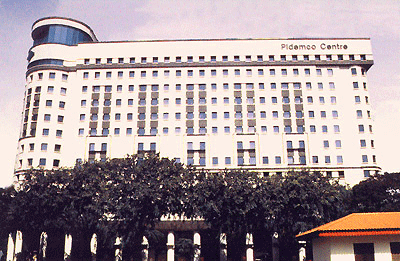

THE PAST
Click the arrow or scroll to begin

1977

Before 1977, the Singapore River was severely polluted. As a response, the government initiated a decade-long clean-up project. By the time Liang Court was built, the river it was situated beside had been transformed into a vibrant and clean waterway (Singapore’s Veteran Shopping Malls Revisited, 2014).

1979

Goh Cheng Liang, founder of Nippon Paint South-East Asia Group, announced a joint venture with Daimaru Inc of Japan. Together they conceptualised a “complex comprising twin towers for a hotel and apartment block as well as a podium block for housing shops, offices, restaurants and carparks” (River Valley, 2016).

1984

Liang Court opened on January 1984. Valued at $400 million, it had Daimaru, luxury apartments, specialty shops and Hotel New Otani (The Straits Times, 1984, p.25). It catered to Japanese tourists and expatriates. It flourished a strong yen and rising tourist numbers (Tan, L, 2016), which peaked at 1.2 million in 1995 (Lee, 2002).

1997

The number of expats in Singapore peaked at 26,684 in 1997 (Lee, 2002). The prolonged recession in Japan since 1990 - termed the 'lost decade' - prompted many Japanese to seek work outside their country for better opportunities, one of which is Singapore (Japan's Business and Economic Relations With Singapore, 2015).


1998
photo courtesy of The Straits TImes
The Asian Financial Crisis struck the region, and in 1998, Japan’s GDP dipped from US$5.449 trillion to US$4.033 trillion (GDP - current US$, 2018). The Japanese community in Singapore began to shrink. Tourist arrivals and the expatriates' spending power dropped (Lee, 2002).

1999

Goh Cheng Liang began selling his stake in various publicly listed companies. For Liang Court in particular, in 1999, he sold his 59% holding to Pidemco Land for $175 million (Jetley, 2013).

2003

With $53 million in losses, Daimaru decided to pull out of Singapore, along with overseas operations (Lee, 2002). With the main draw gone, shopper traffic dwindled even with the addition of Meidi-Ya as a replacement, marking the start of Liang Court’s fall (Lim, W, 2007).

2007

The Japanese Association began recalling their workers back from Singapore during the global financial crisis of 2007–2008. Liang Court's customer base shrank even further, with stores catering to the Japanese market the hardest hit, with some considering giving up their leases.

2008

The dip in business was so bad it motivated Liang Court’s latest landlord, AsiaMalls Management Pte Ltd, to completely revamp the mall for $40 million. Stores selling goods that appealed to a wide audience were also integrated into Liang Court to expand their reach beyond the small Japanese market (Lim, J and Sim, 2009).